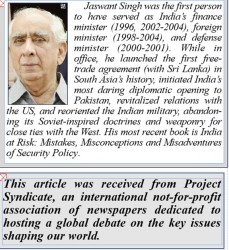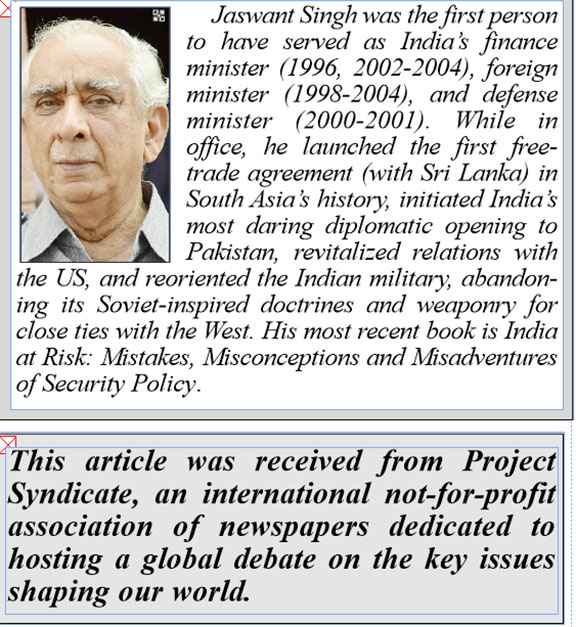By Jaswant Singh
NEW DELHI – Iraq seems to be falling apart, with the rapid advance of the militant Islamic State in Iraq and Syria (ISIS) threatening to lead to the country’s division into Shia, Sunni, and Kurdish entities, while blurring its border with its turbulent western neighbor. Moreover, the tumult is now threatening to spread to two more nearby countries, Afghanistan and Pakistan, which already are facing myriad internal challenges. For India, the message is clear: its national security interests are at risk.
 After almost four decades of war, Afghanistan is, once again, teetering on the edge of a precipice. Just last week, following allegations of massive fraud during the country’s recent presidential election, thousands of protesters marched on the presidential palace. Given that the aggrieved candidate’s constituency comprises mainly ethnic Tajiks, the events have revived Afghanistan’s deep-seated ethnic tensions.
After almost four decades of war, Afghanistan is, once again, teetering on the edge of a precipice. Just last week, following allegations of massive fraud during the country’s recent presidential election, thousands of protesters marched on the presidential palace. Given that the aggrieved candidate’s constituency comprises mainly ethnic Tajiks, the events have revived Afghanistan’s deep-seated ethnic tensions.
Pakistan’s internal struggles – from inter-communal conflict to relentless terrorist activity – are well known. In fact, the country recently experienced a major terrorist attack, which not only led to more than 29 deaths, but also rendered Karachi’s international airport – the country’s largest – dysfunctional for nearly 12 hours. Just a couple of weeks later, gunmen fired at a Pakistan International Airlines plane as it was landing in the northern city of Peshawar, killing one passenger and injuring three crew members.
Poorly considered American interventions, especially the invasion of Iraq in 2003, have exacerbated the region’s myriad animosities and security challenges. Far from bringing peace to Iraq, the military campaign – carried out on the pretense of eliminating weapons of mass destruction – fueled more violence. Unable to stabilize itself, Iraq – which initially demanded that the United States withdraw all of its troops – has been requesting renewed American involvement. Will Afghanistan, too, soon be asking the US to return should the Taliban stage an ISIS-like surge?
Iraq’s struggle as a unified state is nothing new. It began almost exactly a century ago, when the United Kingdom and France created a new map of the Middle East via the Sykes-Picot Agreement. The Pakistani journalist Yasser Latif Hamdani has emphasized the imprudence of the British-French approach, which entailed drawing borders that roped in diverse peoples – the consequences of which are starkly apparent in countries like Iraq and Pakistan.
In this context, as Richard Haass recently pointed out “the potential for prolonged political-religious wars within and across boundaries, involving both local and foreign forces and militias and governments, is great.” Indeed, the region is “unraveling by the hour.”
The momentum is now with ISIS – an Islamist organization even more extreme than Al Qaeda. Though ISIS has often been characterized as a Sunni organization, it is important to note, as Ali Khan Mahmudabad has observed, that the group’s ideology closely resembles that of the radical seventh-century Kharijite sect, which also felt embolden to denounce, and then kill, other Muslims as nonbelievers.
In any case, the Iraqi army is a defeated force. According to the Washington Institute for Near East Policy, almost one-quarter of Iraq’s combatant battalions no longer have an “order of battle” with their equipment lost and their soldiers having abandoned their posts. Similarly, US officials say that more than one-third of Iraqi army divisions are “combat ineffective.”
It is no surprise, therefore, that Iraq has lost control over its border crossings with Syria. In fact, the Iraqi government could even begin to lose its grip on its frontier with Jordan in the not-too-distant future, allowing an entirely new set of destabilizing forces to wreak havoc on its territory. An Iraqi commander recently summed up challenge: “We don’t have enough intelligence information; we don’t have good air coverage; we are battling very well-trained groups that have good experience in street fights that are moving fast between cities and villages.”
The question now is whether the Middle East as we know it will remain intact for much longer. After World War I, the British field marshal Archibald Wavell presciently observed that, “After ‘the war to end war,’” the victors “seem to have been pretty successful in Paris at making a ‘Peace to end Peace.’” He foresaw what now seems obvious: the imposition of artificial arrangements in the Middle East would only engender conflict.
For India, this uncertainty amounts to a serious security challenge, requiring that it transcend the role of silent spectator. After all, India itself is one of the world’s largest Muslim countries, with some 177 million Muslims, both Sunni and Shia. With the forces destabilizing the Middle East unconfined by national borders, India simply cannot risk having the growing Sunni-Shia civil war spread to its population.
The region needs a new security paradigm. For its own sake, and the sake of its neighbors, India must take an active role in creating it, and soon.
Indeed, given China’s growing influence in Pakistan and Afghanistan, this act of diplomatic creation could prove to be a key test of how China views its relations with India. The Chinese can decide to cooperate with India and others to forge a new structure of peace for the greater Middle East or, instead, to use the growing risks that India and its neighbors face to pursue small tactical advantages. India’s relationship with China may depend on this choice for many years to come.










